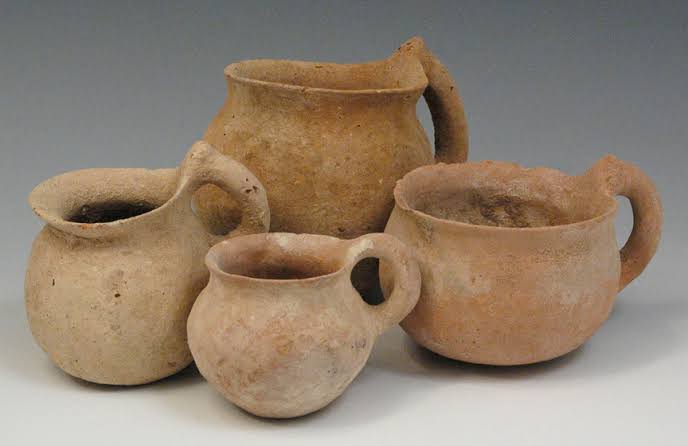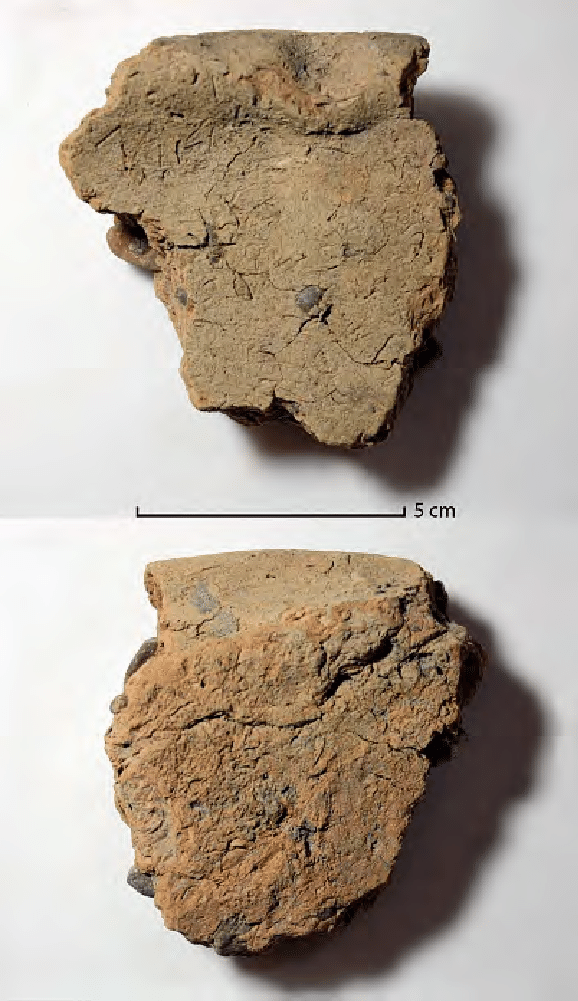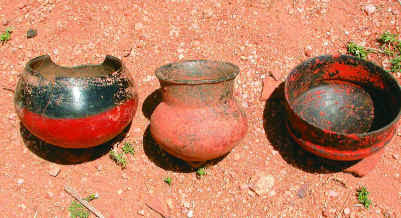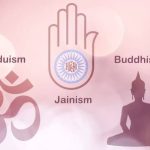Table of Contents
- 1 The History of Pottery
- 2 Different types of potteries in ancient India
- 3 Neolithic Age: Pottery & Artifacts
- 4 Features of Neolithic Age: Pottery & Artifacts
- 5 Age of Chalcolithic | Chalcolithic pottery
- 6 Pottery of the Harappan Civilization
- 7 Vedic Era-PGW | Painted Grey-Ware Pottery
- 8 Later Vedic Era-NBPW | Northern Black Polished Ware
- 9 End of the Later Vedic Period-NBPW
- 10 The Megalithic Age Pottery
The History of Pottery

The art of making pottery is thought to be one of India’s oldest and most important native arts.
It has been around since the beginning of time. “The truest to nature, in the directness and simplicity of its forms, their adaptation to use, and the purest in art” is how Indian pottery is described. In fact, nothing in Indian art has a longer history of artistic accomplishments than clay.
Different types of potteries in ancient India
| Harappan Age | Black and Red Ware; Black on Red Ware |
| Early Vedic Period | Ochre Coloured Pottery (OCP) |
| Later Vedic Period | Painted Grey Ware (PGW) |
| Pre-Mauryan Age | Northern Black Polished Ware (NBPW) |
| Mauryan Age | NBPW |
| Post – Mauryan Age | Red Ware |
| Gupta Age | Red Ware |
It is a well-known fact that the art of pottery in India has reached a high level of perfection through a continuous process of improvement in techniques and artistic expressions. For example, the pottery industry has made improvements in innovative techniques and creative quality of fine output in each period.
Neolithic Age: Pottery & Artifacts

We hear about pottery for the first time at this time. Pottery is always made by hand, but in later times, a footwheel is also used.
Features of Neolithic Age: Pottery & Artifacts
Not polished or burnedished and has a rough surface
Made by hand, rough grey pottery
Material: a mixture of clay, mica, and sand
There is no drawing on pottery.
Many times, rice husk cords were bent and pressed into wet clay to make decorations.
Found all over India, even in the South. Burzahom-coarse grey pottery
There was greyware, black-burnished ware, and matpressed ware.
Age of Chalcolithic | Chalcolithic pottery

During the Chalcolithic Era, the first metal age, different cultures grew up in different parts of India. For example, the Ahar culture grew up in South Eastern Rajasthan, the Malwa culture grew up in Western MP, the Jorwe culture grew up in Western Maharashtra, and so on.
During this time, people used different types of pottery.
Black-and-red-ware Pottery: There seems to have been a lot of black and red ware. Black and red ware pottery with white lines was found in cultures like Ahar Banas.
Black-on-red ware: Jorwe ware is painted black-on-red and has a wash on the surface to make it shiny.
People who made Ochre-Colored Pottery (OCP) are thought to be Harappa’s younger peers.
The Copper Hoard Culture is linked to this pottery because it was found in the upper Ganga Valley and the Ganga Yamuna doab area.
The pottery runs in colour from orange to red.
The OCP culture is thought to have been around between 2000 BC and 1500 BC.
Major sites are- Jodhpura (Rajasthan), Attranjikhera (UP)
Ganeshwar, which is near the Khetri copper mines, was once thought to have OCP, but study has shown that this is not true.
Pottery of the Harappan Civilization

Polished Ware is pottery that has a rough finish.
There were both finished and unpolished kinds of pottery.
Pottery usually has a red finish and is made on a wheel, but some are made by hand.
Things that were polished and fired well.
Most of the pottery is polychrome, which means that it is made with more than two colours.
Most of the pottery is made for everyday use. Most of these pots have flat bottoms.
There are geometric designs and drawings of plants and animals to be seen.
There was also pottery with holes in it, which could be used to strain wine.
The pottery was all the same and mass-thrown, which shows that there was some kind of control and less room for individual creativity.
Rich pottery found at some places shows that there were different levels of wealth in the society.
- Mature Harappa
Harappa’s Burial Wares
Pottery that was polished and painted
The pottery for graves was made in a special way.
shows what the Harappans thought about life after death.
The level of social status was shown by whether or not this pottery was in the grave goods.
2. Late Harappa
Chalcolithic pottery was most common in the late Harappan cultures, which lived from 1900 BC to 1200 BC. Some chalcolithic sites have signs of late Harappan, like the use of burnt bricks and other things. There is OCP on these places.
Burnished black-grey pottery made on a slow wheel was found in the Swat Valley. This looks like pottery from the north of Iran. Pottery that is painted black on red and turned on a wheel can also be found in Swat Valley. This shows that there was a link between Harappa and the Swat Valley.
Grey-ware and Painted Grey Ware, which are usually linked to the Vedic people, have been found with some late Harappan pottery. It has simpler designs than the early and mature periods, which shows that the society is becoming less rich.
Vedic Era-PGW | Painted Grey-Ware Pottery

Painted Grey Ware (PGW) Culture came into being during the Vedic Era.
The Rig Vedic sites have PGW, but there are no iron items or grains.It is called a pre-iron phase of PGW because of this. On the other hand, the Later Vedic sites are thought to be part of the PGW ironphase.
This pottery is from the Iron Age. It was made in the Gangetic plain and the Ghaggar-Hakra valley between about 1200 BC and 600 BC. Mathura was the place with the most PGWs.
A style of fine grey pottery with black geometric designs painted on it.
Are only found in a few places, like Punjab, Haryana, and the upper Ganga Valley. This culture is linked to small towns and villages, but not to big cities.
Later Vedic Era-NBPW | Northern Black Polished Ware

The people of the later Vedic period knew how to make four kinds of pottery: black-and-red ware, black-slipped ware, painted grey ware, and red ware.
End of the Later Vedic Period-NBPW
Around the 6th century BC, at the end of the Later Vedic Age, we see the beginning of the second phase of urbanisation. The first was the Indus Valley Civilization. The Northern Black Polished Ware (NBPW) started during this time.
This map shows where NBPW pottery has been found.
Glazed and shiny pottery.
Fine cloth was used to make the tableware, which was used by the wealthy. Thought of as high-end pottery only found among the wealthy, showing the Brahmanical stratification of society, which was rule. because of
During the Mahajanapada age, this pottery was still made.
Found in Ahichatra, Hastinapur, and Navdatoli, all of which are in the state of Uttar Pradesh.
divided into two categories: bichrome and monochrome
The fabric of one-color pottery is fine and thin. Potted on a fast wheel, and the top is very shiny. 90% of this type is jet black, reddish black, or bluish black, while 10% is pink, golden, brown, or another colour.
Less bichrome pottery is made. It looks like a colourless picture, except that it has a mix of two colours. A piece of Bichrome pottery that has two colours
The Megalithic Age Pottery

Between the 3rd century BC and the 1st century AD, this culture existed.
Megaliths are structures that are made of very large stones.
Large stone graves are one of the most well-known things about this culture. Iron was used a lot in the South during this time.
Kerala has found megalithic pots.
Wheel-thrown and cooked to last
Most of these are plain, but one sherd from Koldihawa has black paint on it.
It has been dug up all over India, but mostly in the South. Most of it in Vindhyas.
They were put in graves, which shows that people thought there was life after death.










![Ancient Indian History Notes for UPSC [Part 4] Vedic age images-11](https://iasbio.com/wp-content/uploads/2021/07/images-11.png)

![Ancient Indian History Notes [Part 3] Indus Valley Civilization 1625136903398_compress46](https://iasbio.com/wp-content/uploads/2021/07/1625136903398_compress46.jpg)



